- remind me tomorrow
- remind me next week
- never remind me
The X Button
Lost in Blues
by Todd Ciolek,

That's happening with Guilty Gear Xrd, which will see its first expansion, subtitled Revelator, before the year is out. And I don't mind, because it's adding characters that I like. We'll get the returning pirate-king Johnny, the all-new chain-swinging, pumpkin-masked Jack-O, and, most recently and most importantly, the martial-arts chef and restaurant proprietor Jam Kuradoberi.
![TADAIMA! SANJOU ARU! [insufferable laughs and squeaking]](/thumbnails/max600x600/cms/the-x-button/91851/ggxrdjam1.jpg)
I actually didn't like Jam when she debuted in Guilty Gear X. I found her voice annoying and the game's habit of positioning her for panty slips to be insulting. But I relented. Jam is a fun character, impulsive and confident and wiling to shake off a lot of the nonsense that Guilty Gear's world constantly sends to wreck her eatery and scare off her customers. And I like playing her, even if the last update for Guilty Gear XX Accent Core Plus I Refuse To Use Its Real Name made it harder to combo into her special moves.
So I'm glad to see Jam in Guilty Gear Xrd. I admit that I care less about how she'll play and more about how she'll react to the fact that Ky, one of the Ken/Ryu mainstays of the series, is now a king and married to the gentle, angel-and-devil-winged demihuman Gear named Dizzy. Jam flirted with Ky here and there in the older Guilty Gear games, but Guilty Gear 2: Overture and Xrd confirmed that Ky wedded Dizzy and had a son named Sin. This development doesn't sit well with some Guilty Gear fans, who resent Dizzy for her meek “moe” aura and the fact that's she biologically three years old but mentally and physically in her twenties (which is sorta the reverse of that gross otaku fantasy of thousand-year-old preteen demons, but I digress). Other fans also dislike how the Ky-Dizzy union undermines the barely masked homoerotic subtext between Ky and Guilty Gear protagonist Sol Badguy. Really, look at the artwork below. That's an official Guilty Gear illustration.

I expect that Jam will be far less upset by the sight of Ky married to Dizzy. Jam has shown herself to be a resilient and self-sustaining woman who cares more for establishing her own restaurant than she does for hitching herself to teacup-collecting knights like Ky. So she'll get over her disappointment in minutes, and then, as the Guilty Gear Xrd artbook implies, she might start a new venture with the cross-dressing nun-boy Bridget. This is an important point in the Guilty Gear canon, I think.
And for those of you not up your obscure Swedish pop groups, Jam is named after Cloudberry Jam.
NEWS
EXIST ARCHIVE COMES INTO FOCUS
All right, Exist Archive: The Other Side of the Sky. They say you're a lot like Valkyrie Profile, and maybe that's true. You share the same sort of side-scrolling levels, the same sort of button-tapping battle system, and the same developer, tri-Ace. There's even some thematic connection. Exist Archive doesn't let you control a valkyrie and nab the bravest of lost souls, but it nonetheless finds its characters wandering a strange afterlife. Young couple Kanata and Ranze go from being the victims of an subway explosion to being soldiers in a battle between gods, and they roam the lush forests and high-tech cities of a world loosely linked to the mortal realm.

Of course, Exist Archive doesn't resemble Valkyrie Profile too much. Its characters look like standard-issue protagonists from modern anime-RPGs, and the resulting storyline has such common points as a mysterious white-haired girl and other allies of dubious morals. That said, it sports some pretty backgrounds and numerous elaborate battle effects. But those characters are of the awkward, big-headed variety, aren't they?
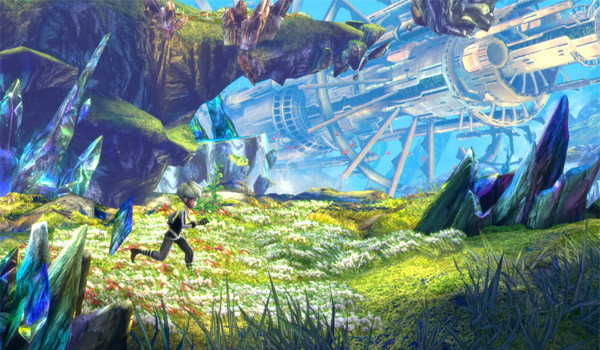
Yes, they are. In both the side-scrolling levels and the battles, the characters are macrocephalic creatures who go about the motions of RPG combat. They look more ungainly than the similarly sized cast of Bravely Default or The Legend of Legacy, perhaps because Exist Archive has a little more detail behind it. Really, the Vita is capable of realistically sized characters, and this'll run on the PlayStation 4 as well. Does every mid-budget RPG have to walk with munchkins?
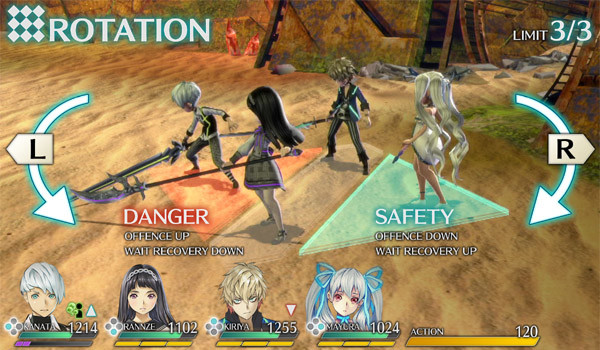
That aside, Exist Archive sounds novel in its borrowings from Valkyrie Profile. It's been too long since an RPG explored the afterlife without dunking itself in parody or inescapable pandering, and Exist Archive seems like it has a straight enough face about its important elements.
RESIDENT EVIL 2 REMAKE IS UNDERWAY
Resident Evil 2 remains my favorite title in the series, and I'm hardly alone in thinking that. True, it's more a tribute to action movies than zombie movies, but it's a perfectly paced tribute in that regard. Its dual-character dynamic is much stronger than it is in subsequent Resident Evil games, and it bounces enjoyably from one memorable spectacle to another. Resident Evil 2 never had the same impact in 1998 as the original Resident Evil did on the fledging PlayStation generation of 1996, and yet it forged many staples of the series. I'd say that merits a remake.
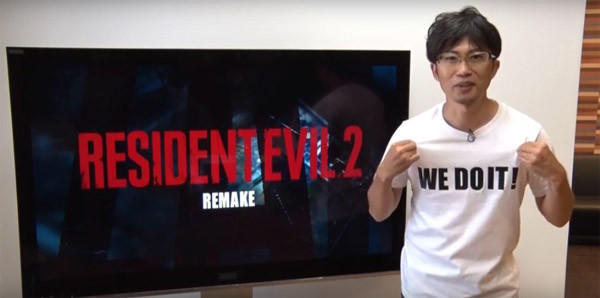
Capcom has a Resident Evil 2 remake in mind. Led by producer Yoshiaki Hirabayashi, the project remains in its early stages. During its announcement, Hirabayashi had nothing more to show than a title screen and a t-shirt. It's a good shirt, though. It's not clear yet just how the remake will change the original's ideas, including the separate quests for stranded cop Leon Kennedy and biker Claire Redfield. I just hope it pays some tribute to Elza Walker, the college student who was going to be a playable lead until Capcom remade the game mid-development and turned her into Claire. The part of me that's still a Gamefan-reading teenager from 1997 wants to play as Elza.
Even if it's a long way away, Resident Evil 2 Remake already had an effect. An independent remake called Resident Evil 2 Reborn showed off a visually impressive re-imagining of the game earlier this year, but its developer Invader Games canceled the game at Capcom's request. There's little sign of resentment between the two, however, as Capcom reportedly even invited Invader staff to discuss their ideas.
REVIEW: LOST DIMENSION
 Developer: Lancarse
Developer: Lancarse
Publisher: Atlus
Platform: PS Vita / PlayStation 3
MSRP: $39.99
The game industry has a minor but unmistakable crush on a certain mystery staple: a cadre of diverse characters held at the mercy of an eccentric figure. Said figure then forces these victims through bizarre challenges that test their integrity and, should you mine deeper, reveal dark ruminations on human nature. Danganronpa did it with high-school stereotypes and a maniacal two-tone bear antagonist. Zero Escape did it with oddball strangers and a cavorting rabbit puppet. Lost Dimension does it with a much straighter face.
The earth is in the grip of a seemingly omnipotent terrorist named The End. Upon massacring a shocking percentage of the civilized world, The End holes up in a towering fortress called The Pillar at the heart of a destroyed city, and he threatens to finish his apocalyptic task. The only ones to make it inside The Pillar are a dozen operatives from the international task force called S.E.A.L.E.D., all of them armed with combat prowess and varying psychic abilities. Pyrokinetic Himeno Akatsuki tosses fire and disinterested comments. Cheerful Agito Yuki warps around like a ninja and slashes away. Swordfighter George Jackman absorbs abilities from enemies—and spouts heroic catchphrases like the big American lummox he is.

Like any oddly dressed lunatic with too much free time, The End toys with his would-be assassins. He allows them to pass each of The Pillar's five levels only if they're willing to kill off one of their own. And to muddy the waters a little, he reveals on each floor that someone among them is a traitor. In the game's most intriguing turn, it's up to the player, controlling team leader Sho Kasugi, to figure out the traitor's identity for every stage and, if he knows what's best, convince the other group members to sacrifice the enemy in their midst.
Fortunately, Sho has more than guesswork at his disposal. His personal psychic ability is mind-probing, so he picks up vaguely traitorous resonances after each of the game's missions. His powers narrow it down to three possible suspects, and from there the player must figure out the spy's identity through trial, error, and a walk through the team member's foggy mental landscape. Sho only receives points for three such dives per floor, and if he guesses wrong, he loses one loyal teammate—and the traitor turns on the group anyway.
The team deals with more than internal strife on their ascent of The End's bizarrely fortified pillar. Each floor breaks into missions pitting six chosen S.E.A.L.E.D. members against The End's mechanized soldiers, tanks, and drones. Combat plays out much like Valkyria Chronicles, as characters roam within circular wireframes, position themselves, and strike if their distance to the target allows. It's also possible for team members to give their turns to others and, better yet, join together in support attacks with other nearby allies.
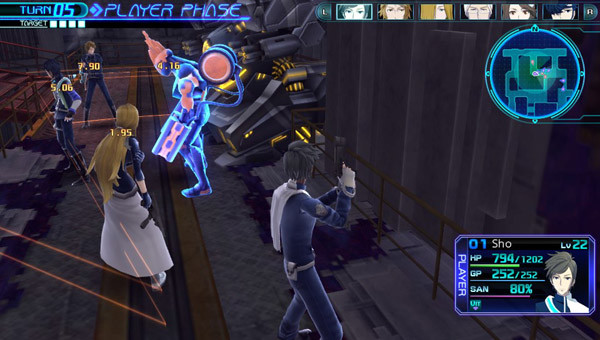
Lost Dimension proves enjoyable there. Missions are quick, efficient battles ideally suited to a handheld system, and they often come down to positioning characters just the right way to wipe out enemies with a team manuever. Firearms and bladed weapons provide the basic attacks, while each S.E.A.L.E.D. operative gets a unique set of psychic assault methods, buffs, and debuffs. All of their mental abilities are upgraded through a standard skill chart, and the game mercifully retains a character's skills even when he or she is offered up and vaporized at the end of a floor. Former teammates may be disintegrated, but their skills remain in little cubes that other characters can equip. How morbid.
If the combat is appealing, it's not particularly memorable. The enemies show little variety, with each stage offering the same color-coded mechanized soldiers and the occasional looming battletank. The brevity of each stage makes them easily digestible, rarely asking anything more complex than wiping out all foes. The game's design sensibilities find mediocre graphics supporting some interesting design work; The End's tower is an apparently alien piece of architecture, but too much of the interior gives way to concrete mazes and dilapidated gardens. There's a lot of Persona in the game, from the bleak pop-backed intro, the perky yet haunting soundtrack, and the formal character designs. It's also relatively free of creepy undertones, apart from optional costumes and the fact that every woman wears either a skirt or a flowing dress. The original Star Trek was a long time ago, Lost Dimension.
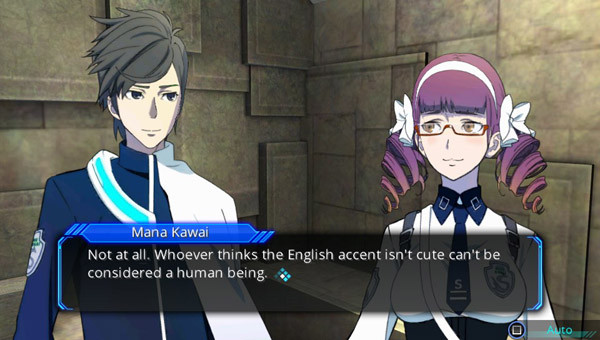
Lost Dimension's unambitious looks and quick battles only support the true hook: the hunt for traitors. Ferreting out a backstabber is a novel idea for a strategy RPG, and Lost Dimension makes the daring move of randomizing each traitor's identity. The first stage's double agent is predetermined, but the four that follow are determined entirely by chance. It's just as likely to be the blunt Himeno as it is the upbeat, faux-British Mana Kawai. So the guessing game ensues as you drag various party members into battle and sift them for suspicious thoughts. It's sometimes hard to accept when the traitor is a likeable character or a useful party member, but finding out is easily the best part of the game.
Discovering traitors would hit even harder if the characters proved more enduring. Yet they're the same batch of stereotypes we've seen many times before in RPGs, anime, and their hinterlands. Even as Sho befriends his teammates in Persona-style chit chat, they seldom get interesting. Nagi's dealing with the self-doubts that come with being a career soldier. Marco is meek little guy with an unpleasant past. Zenji's asshole demeanor masks a deeper insecurity. Agito is laid-back almost to the point of comical suicide. Telepathic Yoko just wanted to be a pop idol instead of raiding a world-threatening tyrant's fortress. From what I've heard of the idol market, she got off easy.
Lost Dimension simply can't turn them into truly lasting characters. It's easy to sympathize with the S.E.A.L.E.D. members when they're pinned down in battle or outed as traitors, and yet, like the rest of Lost Dimension, they entertain while they're around and slip away not long after. Clearly influenced by the Persona games (and written by some tangentially connected people), the script relies too much on clichés. While the voice acting is decent, the localization is only textbook competent, sticking too many team members with stiff vocabularies and robotic cadences. Lost Dimension also insists on dragging out conversations by giving every person a few lines even when they have nothing to add, as though every character had a talent agent demanding dialogue quotas.

Yet the blame lies with the traitor hunts themselves. It's a thrill to track down the culprit when they're denoted at random, but it robs the characters of their genuine motives. They may turn on you, but they aren't doing it because of personal grudges or Machiavellian hubris or unsubtle allegories for the music industry. They're doing it because of the the convoluted backstory and the results of a dice-roll. It isn't Sojiro or Yoko or Nagi who truly betrays you. It's the game.
Many games give the player the chance to mold characters or throw them away entirely, but the best examples leave those characters a consistent core of personality no matter what happens. Cheripha is a sunny, hopeful ex-assassin whether the player sacrifices her or not in Valkyrie Profile: Covenant of the Plume. Chie Satonaka might end Persona 4 as the hero's true love or just a good high-school friend, but she'll stay an upbeat martial-arts nut. Slay him or recruit him or neglect him, and yet Ignus will spend Planescape: Torment as a crazy pyro-mage. Lost Dimension doesn't solidify its cast enough to matter.
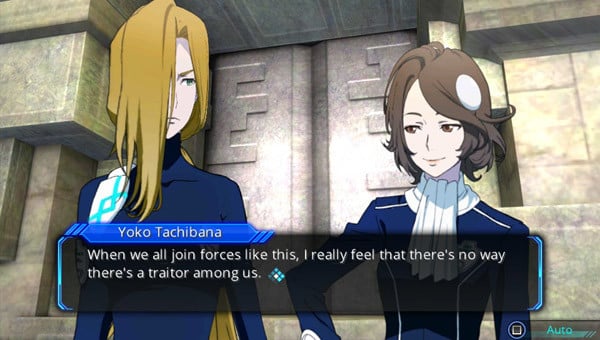
Lost Dimension also unveils its own traitorous move. While an initial playthrough isn't that long, players have to hunt through the game a second time in order to befriend every team member, get the best ending, and learn just what The End and the traitors were plotting. It's not as fun the second time through, and you might need a third (or fourth) run if the traitor selection keeps you from becoming best pals with the entire S.E.A.L.E.D. unit. It's also far too tempting to replay the easiest first-level missions as you're rooting for traitors. But that's on you, after all.
So Lost Dimension is a nice enough mystery: compelling while it lasts, but flawed, clichéd, and easily forgotten once it passes. The rush of tracking down traitors and racing through battlefields makes for a fun diversion, even if its characters can't bring you to care as much as you might in a good Persona entry or a Danganronpa title. This isn't a game to inspire grand memories or even provoke a lot of half-joking fan debates about which female character is the best fantasy spouse. The appeal won't linger, but Lost Dimension holds itself together just long enough.
NEXT WEEK'S RELEASES
AMNESIA: MEMORIES Developer: Idea Factory
Developer: Idea Factory Publisher: Idea Factory International Platform: PS Vita / PlayStation 3 / Steam Release Date: August 25 The Truth: She's half-human, half-Esper MSRP: $39.99 / $54.98 (special edition) Where would video games be without amnesia? It appears in everything from Final Fantasy VI and Planescape: Torment to recent sights like Lost Dimension. Cliché it may be, but there's no easier way for designers to drop the player into a role where a character discovers everything anew, just as the player does. And that's where Amnesia: Memories takes over. It offers a blank slate, and not just in the typical sense of a reluctant heroine who rarely decides anything without the player's direction. The heroine is a college student without any recollections of her past, so she's out to rebuild her life from scratch. Not that Amnesia: Memories is tied to medical accuracy. The heroine's best ally in regaining her memories is Orion, a vaguely devilish boy seemingly invisible to everyone but our protagonist. The surrounding cast teems with attractive young men, all of them somehow related to the aforementioned missing memories. The distant, ambitious Shin is first in line, being right there to kiss the heroine when she awakens at the game's outset, but he's followed by the skilled and sometimes creepy playboy Ikki, the stiff and nerdy graduate student Kent, the protective and possibly unhinged Toma, and the genuinely mysterious (and probably tragically inclined) Ukyo. The heroine picks a possibly boyfriend early on, and this influences the following storyline—and the dimension in which it unfolds. Characters differ in their roles from one world to another; a handsome major character might be a childhood friend in one path, but a more distant acquaintance in another. To keep track of just what storyline she's pursuing, the heroine consults her cell phone and measures her progress in the fields of affection, trust, and suspicion. It seems a step above those visual novels where you're merely exploring new storylines instead of largely different realities, but I'll leave it to the physicists to argue that.
|
MEGA MAN LEGACY COLLECTION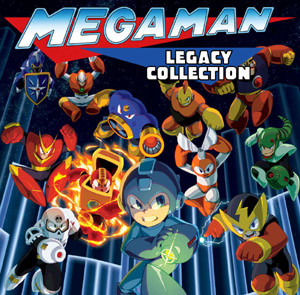 Developer: Capcom/Digital Eclipse
Developer: Capcom/Digital Eclipse Publisher: Capcom Platform: PlayStation 4 / Xbox One / PC (Steam) Release Date: August 25 See Also: Astro Boy, Casshern MSRP: $14.99 Mega Man's origins were humble: an impressive but not entirely successful NES action game starring a hero who was half plucky Tezuka robot, half walking weapons arsenal. Mega Man battled six renegade machine lords and their master, and along the way he gained the armaments of defeated bosses. It was an excellent idea for an early NES game, though it wasn't until the sequel, made by determined Capcom programmers in their spare time, that Mega Man finally arrived. He's not Mario or Link or even Sonic, but Mega Man's had his share of comics, cartoons, spin-offs, and, of course, scores of video games. Capcom's ignored Mega Man in recent years, so much so that former series steward Keiji Inafune started up his own revamp in Mighty No. 9. Yet Mega Man's keepers now let him out more often. The Legacy Collection is a reminder of just why Mega Man was important in the days of the NES, and that's not just because it contains the first six major games in the series. It also gathers production artwork and a character database that tells you, among other things, what innocent purposes those enemy robots knew before they were wired for evil. Of particular interest is the Challenge Mode, which remixes level pieces from the six games into shish-kabob stages where you might face a tough boss gauntlet or just jump across every game's obligatory crop of disappearing blocks. Those were always tough. Can't we get these Mega Man games on the Wii's Virtual Console, the PlayStation Classics store, and that Mega Man Anniversary Collection that's you can still find brand new for the PlayStation 2 and Xbox? Well…yes. But Legacy Collection is a painstakingly assembled port of the first six games, with varied filters providing everything from perfectly sharp pixels to the ghosting, blurred effects you got when you hooked up your NES to grandma's old TV that one summer. And for the Mega Man fan, it's a good way to tell Capcom that there's still support for the series—even if it's just support for more carefully assembled collections.
|
Steins;Gate already came here on the PC, but next week gives us the chance to get it on the PlayStation 3 as well as that bastion of visual novels, the Vita. The game remains a selectively animated adventure about a team of garage scientists and the horror their time-travel experiments bring, and the player interacts through a primitive temporal gadget as well the usual dialogue choices. You can nab the regular edition for forty bucks, while the specia…sorry, the El Psy Kongroo Edition has an artbook, a badge set, and a Metal Upa figure. That's only available at Rice Digital, though, and it seems like the sort of thing that'll sell out quick. Folks love Metal Upa.
One Piece: Pirate Warriors 3 hits the PlayStation 3, PlayStation 4, and, in a mildly surprising turn, Steam. It gathers up nearly 40 playable characters from Eiichiro Oda's vast pirate adventure series, and that number doesn't include another ten supporting characters…or the improved team-up system that allows four characters to join up and attack at a time. Of course, Pirate Warriors remains a brawler that's primarily about smacking around gobs of enemies with every character's powerful attacks, but it's fully faithful to One Piece canon. Should you be bored with the game's coverage of that canon up through the Dressrosa arc, you might jump into the numerous “Dream” side-quests beholden to no prior narratives. After all, One Piece fans have seen the real storylines already.
discuss this in the forum (12 posts) |
this article has been modified since it was originally posted; see change history